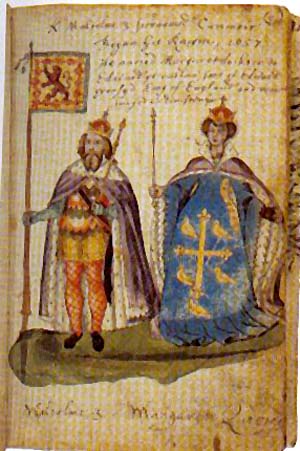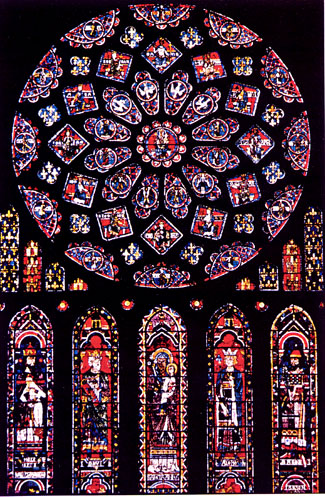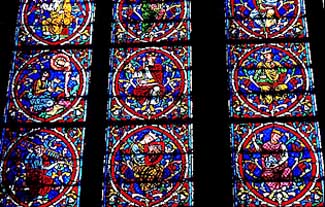 |
The Saint of the Day
St. Margaret of Scotland, June 10
Prof. Plinio Corrêa de Oliveira
Biographical selection:

St. Margaret of Scotland & King Malcolm III - illustration from the 16th century Seton Armorial
|
St. Margaret was Queen of Scotland. Her father, Edward Atheling, was the Saxon heir to the throne of England, and her mother was a German princess, the descendant of Emperors. Like the strong woman of the Gospel, the practice of Catholic virtues made her still more illustrious.
After the Norman Conquest, many members of the English nobility, including Margaret, found refuge in the court of Malcolm III of Scotland. In 1070, Malcolm married Margaret and made her Queen of Scotland.
Margaret impressed the Scottish court both with her knowledge of continental customs and also with her piety. For the love of God she imposed upon herself severe mortifications, leaving aside the superfluous and often even the necessary. She influenced her husband and son to govern better and introduced Catholic customs, manners and ceremony to the Scottish court. She raised her sons in great piety and one, David, was later canonized. Above all she excelled in her zealous charity for her neighbor. She was called “the mother of orphans” and “the bursar for the poor of Jesus Christ.”
In 1093, after six months of great physical suffering, she delivered her soul to God in Edinburgh. The sanctity of her life and the numerous miracles she worked both in her life and after her death made her famous worldwide.
In 1673, Pope Clement X named her the patroness of Scotland, over which she had reigned for almost a quarter century.
Comments of Prof. Plinio:

Margaret lands in Scotland in 1068 and is received by King Malcolm III
|
The life of St. Margaret prompts me to comment on the spirit of the marvelous in the Middle Ages. I am not speaking of the marvelous as a fable or tale, as something unfeasible, but of the marvelous as something that can become reality.
The foggy Scotland of that time was still far from being a civilized nation. In many senses it was still barbarian. Then, in that rough environment a flower bloomed. Divine Providence brought to that Island a Princess of the most illustrious blood, who had in her the best of Western Civilization.
Further, she herself was a saintly woman, a valiant wife, and a wonderful mother who raised her children perfectly, interceded for her people, and became known for her constant and generous alms. She also worked miracles. And she did all this under the prestige and unction of the royal crown.
This ensemble of facts communicates a message to us: that the marvelous, the extraordinary, the stupendous can be realized in this world. This fact is drawn from the fullness of that Catholic principle (the axiological principle) which says that when everything is ordered, good, true and sublime, it generates the realization of the plan of God on this earth.

The Chartres windows, above, illustrates the world of the marvelous; below, a detail from a window in Notre Dame Cathedral, Paris
 |
The life of St. Margaret sends us a message that is the opposite of the minimalism sustained by many Catholics of our days. That is to say, today, when a person manages to reform and become a little less bad, this is already considered a triumph.
In the time of St. Margaret the apostolate was maximalist. The goal was for the queens and kings to become nothing less than saints. And, in fact, many queens, like St. Margaret of Scotland, were saints and spread the precious perfume of Jesus Christ throughout society, creating an atmosphere of the marvelous in Catholic Civilization.
We can understand this atmosphere when we consider the medieval stained glass windows. When we enter the world portrayed in those stained glass windows, we see a Queen presented in a world of multiple brilliant colors - gold, ruby, emerald. This gives us an idea of how the medievals used to think about life, for instance, the life of St. Margaret of Scotland.
One of the advantages of this search for the marvelous is that it fills the soul of the people with what is correct and upright. That is, it fills the soul with the marvelous world of Our Lord Jesus Christ and its extension into the temporal sphere.
When such values do not pervade the souls of people, they begin to travel in the wrong direction. They start to create idols like movie stars, rock singers, football players, and so on, to replace the real models that should be admired.
We can see how blessed the Middle Ages was with its correct models and admiration for the marvelous. In the opposite sense, we can see how it is a chastisement for us to no longer have these models.
We should long for the time when this admiration for the marvelous will be restored, which will be the Reign of Mary. Let us pray to St. Margaret of Scotland to help us merit the coming of this new marvelous era.


  | | Prof. Plinio Corrêa de Oliveira | |
The Saint of the Day features highlights from the lives of saints based on comments made by the late Prof. Plinio Corrêa de Oliveira. Following the example of St. John Bosco who used to make similar talks for the boys of his College, each evening it was Prof. Plinio’s custom to make a short commentary on the lives of the next day’s saint in a meeting for youth in order to encourage them in the practice of virtue and love for the Catholic Church. TIA thought that its readers could profit from these valuable commentaries.
The texts of both the biographical data and the comments come from personal notes taken by Atila S. Guimarães from 1964 to 1995. Given the fact that the source is a personal notebook, it is possible that at times the biographic notes transcribed here will not rigorously follow the original text read by Prof. Plinio. The commentaries have also been adapted and translated for TIA’s site.
|
Saint of the Day | Home | Books | CDs | Search | Contact Us | Donate

© 2002- Tradition in Action, Inc. All Rights Reserved
|
 |

|